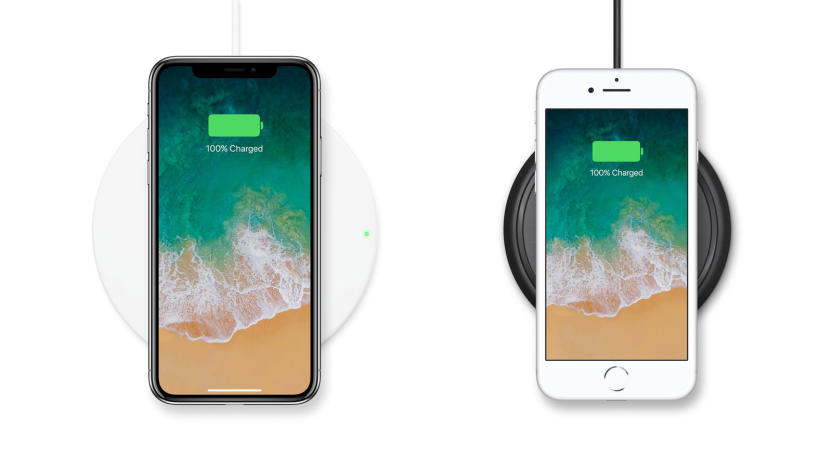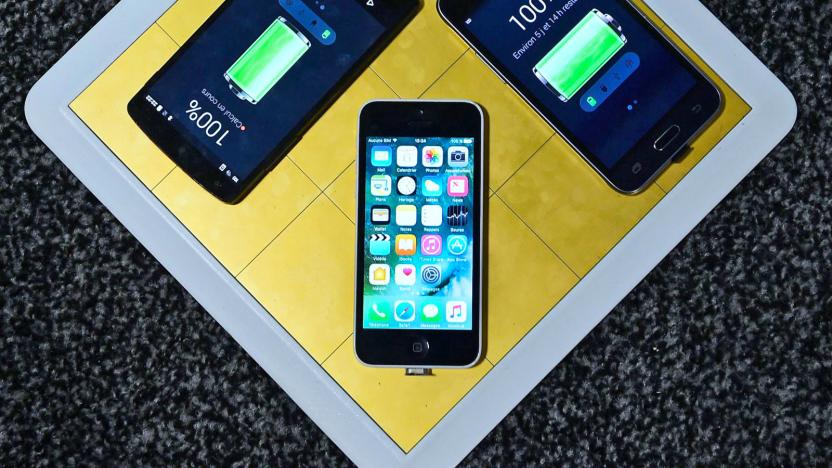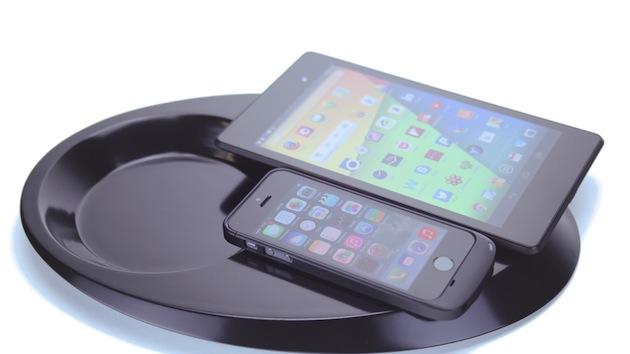WirelessPowerConsortium
Latest

Wireless charging nears unification as Powermat cedes to Qi
Consumers have been living with multiple wireless charging standards for six years, but those annoying times are nearly over. Powermat, which uses the Airfuel Inductive standard that is the only real contender to the dominant format Qi, has joined the Wireless Power Consortium (WPC) and now backs Qi. "Qi has become the dominant wireless charging standard on the market and the recently launched Apple iPhone lineup is evidence of this success," Powermat said in a statement. "[We] will share technology innovation to further unlock wireless charging potential, and will expedite the growth of the wireless charging infrastructure."
Steve Dent01.08.2018
Apple takes a big step toward wireless charging on iPhones
Rumors have swirled for a while that Apple might embrace wireless charging beyond smartwatches (including for the next iPhone), and the company only seems to be stoking those expectations. Apple has quietly joined the Wireless Power Consortium, which governs the Qi standard you see on most devices with wireless charging. This doesn't guarantee that this year's iPhone will tout wireless charging, or even that Apple will use the Qi standard at all (the Apple Watch uses a modified take on Qi). However, it does say a lot about Apple's broader wireless charging strategy.
Jon Fingas02.13.2017
Latest Qi spec promises fast wireless charging for your phone
Before long, you won't have to choose between charging your phone quickly and plunking it on a convenient wireless charger. The Wireless Power Consortium has rolled out a new version of the Qi standard that supports 15W fast wireless charging, much like the sort we saw late last year. The organization isn't making any performance claims at the moment, and it'll be a while before phone makers have compatible devices on store shelves. However, it's safe to say that this will save you some agonizing wait times -- you could return home from work, drop your phone on a pad and expect to have a meaningful amount of energy when you head out for the evening. [Image credit: Aaron Yoo, Flickr]
Jon Fingas06.24.2015
With Qi wireless charging, you'll soon be able to charge your device from a short distance
It's becoming more and more common to find mobile devices with wireless charging capability, either as a built-in feature or integrated into third-party cases. Progress has been somewhat hampered, however, by the fact that no universally adopted standard is available. Of the three major groups trying to corner the market, Qi -- a standard created by the Wireless Power Consortium (WPC) -- has arguably been the most successful at courting manufacturers and carriers (over 200 have signed up so far). The problem is, its abilities have been limited because it only uses a method called inductive charging; in other words, you can power up your smartphone as long as it's sitting on a charging pad. Wireless, sure, but it's still only marginally more convenient than simply plugging the handset in. Fortunately, Qi's adding some crucial functionality later this year that will allow you to charge your device from nearly two inches away.
Brad Molen07.31.2014
Broadcom's new chip lets your phone use any wireless charging standard
Wonder why only a handful of mobile devices support wireless charging? It's partly because the standards are horribly fragmented: companies have to choose between technologies like PMA, Rezence and Qi, and it's not clear which of those will last. Broadcom might put the issue to bed with its new (and awkwardly titled) BCM59350 chip, though. The hardware lets gadgets charge using any existing wireless technology -- you won't have to hunt for specific charging pads. It can also handle up to 7.5W of power instead of the usual 5W, so your gear might charge faster than it would using old-fashioned wires.
Jon Fingas05.28.2014
Qualcomm joins Power Matters Alliance, will help develop hybrid wireless charging standard
Competition is really heating up in the wireless charging space. Last month, the Wireless Power Consortium (WPC) shared news that Qualcomm joined its board, and now the competing Power Matters Alliance (PMA) is making a similar announcement. Qualcomm has also signed on with the PMA, and will be taking on a "senior leadership role" at the organization. The chipset manufacturer is reportedly aiding in the development of a new specification that will enable PMA devices (such as Powermat) to receive wireless power using both low-frequency induction and high-frequency resonance. If that tech is implemented, certain smartphones and other gadgets will be compatible with a wider range of wireless charging devices. Meanwhile, the clock is ticking on product announcements from other members, such as AT&T, which previously committed to lighting up several devices with PMA charging by 2014.
Zach Honig10.01.2013
Qualcomm joins Wireless Power Consortium board, sparks hope for A4WP and Qi unification
Qualcomm, the founding member of Alliance for Wireless Power (or A4WP in short), made a surprise move today by joining the management board of the rival Wireless Power Consortium (or WPC), the group behind the already commercially available Qi standard. This is quite an interesting development considering how both alliances have been openly critical of each other, and yet now there's a chance of seeing just one standard getting the best of both worlds. That is, of course, dependent on Qualcomm's real intentions behind joining the WPC.
Richard Lai09.20.2013
LG VS870 surfaces at the FCC and WPC, may be an Escape for Verizon
AT&T brought out the LG Escape late last summer as a low-cost Android option with a better-than-usual battery and solid performance. If recent testing is any indicator, a Verizon edition might be in the cards. An LG VS870 (the Escape is the P870) has appeared at the FCC wielding support for Verizon's CDMA and LTE networks. Lest we worry that it's just a simple network switch, there's clues that Verizon is planning a little more: the same phone has already appeared at the Wireless Power Consortium, hinting at Qi wireless charging. How else it might change from the 4.3-inch Escape, if it's indeed similar, isn't visible. There might only be a short wait before we find out, as the roughly equivalent Lucid is long enough in the tooth that a replacement would be very timely.
Jon Fingas01.22.2013
Fulton Innovation to demo tablet that doubles as wireless charging mat at CES
Fulton Innovation comes to CES each year armed with the latest tricks in the field of wireless charging, and this year is no exception. Starting things out with a bang, the purveyor of all things Qi will be on-hand to demonstrate its newest feat: the ability to charge your Qi-compatible phone... on the back of a tablet. Indeed, your 7- to 10-inch slate may someday be able to double as its own wireless charging mat, allowing you to feed battery from your tablet to your smartphone just by holding the two devices back-to-back. Additionally, Fulton promises to show off a multi-device charging platform capable of powering up two devices simultaneously. Even better, this surface can recognize and adapt to the needs of each particular product -- in other words, tablets and smartphones can charge together on the same pad, each device receiving the proper amount of juice. Check out the video and press release past the break to see a few ideas Fulton is bringing to the table this week, and fortunately we'll get to take a closer look at all of them soon.
Brad Molen01.06.2013
TI joins the Alliance for Wireless Power, tells the WPC it can still be friends
It's not quite a "Dear John" letter, but we're sure the Wireless Power Consortium is heartbroken all the same. One of its key members, TI, has just signed up for the Alliance for Wireless Power to build cable-free charging on what's effectively a competing standard. The chip designer doesn't view the move as abandoning a long-time partner, though -- it remains part of the WPC and plans to produce Qi-based wireless power chipsets alongside future A4WP components. Without any related chips to announce, there's a long wait left before we know how well TI can juggle the two charging formats without appearing to play favorites. We'd recommend that the WPC not grow too attached in the meantime.
Jon Fingas12.08.2012
TI details the wireless power chip in the Lumia 920, offers four times the charging area
If you're one of the first on your block to have picked up a Nokia Lumia 920, you might wonder why it's so forgiving with where you set it down on the wireless charging pad. TI is more than willing to share. The 920, 820, Fatboy charging pillow and JBL PowerUp speaker all use a new TI bq500410A controller whose support for new transmitters gives it a charging area four times larger than we're used to. The 2.76 by 0.79 inches of coverage might not sound like much, but it's much wider than the previous 0.71 square inches while preserving a 70 percent efficiency and a safety cutoff if something gets in between. As a companion, there's a bq51050B chip launching at the same time that represents the first Qi receiver with its own built-in battery charger, which TI claims can charge more quickly and in less space than its rivals. Anyone embracing Nokia's vision of Windows Phone 8 can get their hands on devices using the wireless power chips today; we're only left hoping that TI's official news means other phone makers can tag along.
Jon Fingas11.07.2012
LG Spectrum 2 made official for Verizon, brings Optimus LTE II to the US for $100
Hints that LG would bring the Optimus LTE II to Verizon have persisted since the spring, which almost led us to wonder if the smartphone was still coming: not to fear, as it's finally here under the Spectrum 2 badge. Other than the expected switch-ups in navigation keys and the mix of both CDMA with global GSM roaming, the design will feel very familiar to anyone who's been on a trip to South Korea lately. The Spectrum 2 preserves the 4.7-inch AH-IPS display, dual-core 1.5GHz Snapdragon S4, 8-megapixel camera, 16GB of storage and support for wireless charging for those who buy a charging pad. We're also expecting a relatively light tweak of the software that keeps it running Android 4.0 for now, with LG's support for Tag+ stickers and QuickMemo being the standouts. We do wish we were looking at a quad-core Optimus G instead. For the moderate $100 post-rebate price, however, we'll take the two fewer processor cores -- especially when the Spectrum 2 is already on sale online and should be in retail stores sometime in the next few weeks.
Jon Fingas10.30.2012
Scientists tweak wireless power transfer, Tesla nods happily in his grave
Wireless charging may be all the rage these days, but actually beaming electricity -- as sketched above by the man Tesla himself -- still has some snags. North Carolina State U researchers have found a way to possibly vanquish the biggest problem: the difficulty of exactly matching resonant frequencies to amplify current. If external factors like temperature change the tuning of a transmitter even slightly then power drops will occur, but circuitry developed by the NC State scientists would allow receivers to detect these changes and automatically re-tune themselves to match. This could make for more potent car and device charging in the future and, if they stretch the distances a bit, maybe we'll finally get the wire-free utopia Nikola dreamed up 120 years ago.
Steve Dent05.16.2012
Samsung, Qualcomm start up Alliance for Wireless Power to take on Qi
Wireless power has until now been closely associated with the Wireless Power Consortium's Qi standard. There's now a second proposed common ground in the Alliance for Wireless Power, or A4WP. Samsung and Qualcomm, along with some help from Powermat, SK Telecom, Ever Win Industries, Gill Industries and Peiker Acustic, are making an alternative that allows for "spatial freedom" between your gadget and the charging source, although whether or not that's better than the 1.6-inch distance of the updated Qi spec is left to the imagination. The strategy doesn't just let your device avoid French kissing the charger: it lets you power up through a material besides a metal plate, and it reduces the cost by eliminating repeaters. A4WP should power everything from low-power headsets through to smartphones and tablets, although with partnership talk just getting started at CTIA Wireless 2012, we wouldn't hold off on buying wired-power gadgets in the near future.
Jon Fingas05.08.2012
WPC updates Qi standard, increases inductive charging distance to 40mm
It seems that Power Matt just got a bit more, er, powerful. The Wireless Power Consortium announced today that it's improved the Qi inductive-charging standard to "include longer range magnetic resonance wireless charging." Effectively, this means charging stations that are up to spec will be able to transmit up to 5 watts of power from distances of 40mm (up from 5mm, previously) to Qi-enabled devices. The WPC says it's ideal for pushing power through the likes tables and counter tops, and that it currently has 12 types of compatible transmitters ready for action. All in all, it certainly seems like a solid step for finally getting rid of all that cable clutter at your workstation -- especially if it'll rid users of those less-than-pretty looking charging bases. Maybe a last-minute add-on to your Uppleva, IKEA?
Joe Pollicino04.20.2012
Fulton Innovation ready to show off new wireless charging techniques at CES
Judging by the number of announcements the company makes this time of year, Fulton Innovation absolutely loves CES. And as to be expected, the inductive charging superstars are tackling CES 2012 head-on to show off the techniques it's been working on for the past year. At this year's show, Fulton will demonstrate the ability to wirelessly charge through a metal surface, show off a car with interior surfaces enabled with the Qi inductive charging standard and display the technology being used inside a handbag. We're pretty eager to see how it all works in real life, so we'll bring you coverage as the show progresses. Feel free to gaze upon the press release below in the meantime.
Brad Molen01.09.2012
Wireless Power Consortium launches Qi certification lab, cuts power cords for approved devices
The power of Qi has grown and grown since the wireless charging standard was finalized. With cord cutting becoming more desirable -- and dare we say, de rigeur, for many mobile devices -- the Wireless Power Consortium (WPC) has launched an independent lab to certify gadgets wanting on its induction charging bandwagon. TÜV Rheinland's providing the speedy certification services at its Taiwanese testing facility, so we should see the legion of Qi-powered devices continue to grow at an ever-increasing rate. Guess Power Matt made the right move joining the WPC superfriends. Qi's up, cords down, playa.
Michael Gorman08.01.2011
Engadget Primed: how wireless and inductive charging works
Primed goes in-depth on the technobabble you hear on Engadget every day -- we dig deep into each topic's history and how it benefits our lives. Looking to suggest a piece of technology for us to break down? Drop us a line at primed *at* engadget *dawt* com. The world of wireless is dragging us into the 21st century kicking and screaming. Our treatise on NFC was a great sneak peek into how our future will play out over the next five years, but we're also seeing other types of suave new tricks coming out as short-range wireless technology creeps closer to the mainstream. Wireless is the crux of convenience that will keep us calm enough to make our way through this speed-demon culture. It didn't take long for our quest to obtain simpler and faster everything to become an obsession, and it shows no signs of stopping; on the contrary, it's only speeding up exponentially at a rate even manufacturers have a hard time keeping up with. Wireless charging is making some serious headway in public mindshare. Once confined to toothbrushes and other simple household items, it's now a handy means of powering phones (HP's Touchstone, for example) and media players, and it'll soon be ready to charge up our notebooks and cameras at our command. Are we sure this is the future, or will this just be a passing fad? Why should it matter? Read on after the break to get the air-conditioned answers to those burning questions.
Brad Molen06.24.2011
Power Matt joins the Wireless Power Consortium, gains the power of Qi
Powermat's Power Matt proclaimed his cord-cutting capabilities to the people while bearing a striking resemblance to Superman. And now, just as the Kryptonian joined the Justice League, Power Matt has teamed up with the Wireless Power Consortium to benefit all mankind -- or at least get us closer to universal contactless chargers. With the pun-loving hero embracing the power of Qi, we're just a Touchstone away from induction charging nirvana... and the next great action flick, too.
Michael Gorman05.14.2011
Global Qi wireless power standard released, Energizer and Sanyo announce products
It's no good buying an eCoupled inductive charger if it won't work with your Powermat, or your Touchstone. Non-standard chargers suck, so we're glad to see that the Global Qi wireless power standard has been released, and the first products have been announced. A number of companies, Nokia and RIM to name but a few, have signed on their support, with Energizer stepping up first with the Energizer Inductive Charger. When it releases this fall it will initially work with charging sleeves for the iPhone 3G/S and BlackBerry Curve 8900, but we presume others will be coming. More promising is Sanyo, which is designing battery packs "without making any change in designs and aspects of existing mobile devices." In other words: they'll look and act like a normal battery pack, but also be able to be charged wirelessly. Beware, ubiquitous micro-USB charger: your days are numbered.
Tim Stevens09.03.2010